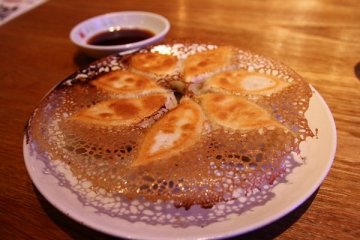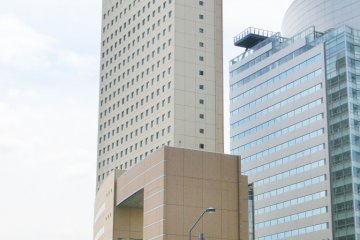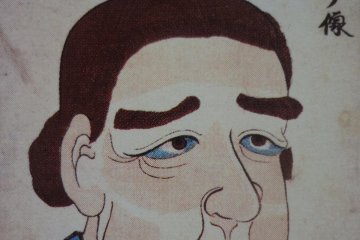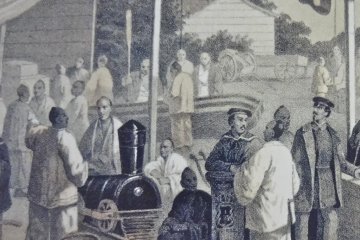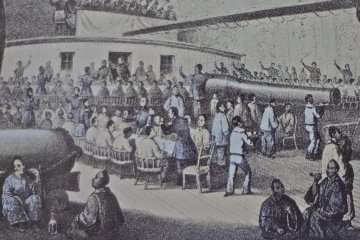Commodore Matthew Perry first landed on Japanese soil in 1853, and in the following year, he succeeded in concluding the Convention of Kanagawa, which finally led Japan to open her doors to the rest of the world. The Yokohama Archives of History stands on the place where this Treaty was concluded.
Yokohama Archives of History
The museum is composed of two buildings: An older building which housed the British Consulate General in Yokohama, and a newer building which has an exhibition hall, lecture hall and reading room. The older building is a historical record in itself. The original waiting room, a corridor and a small booth for a telephone are open to the public. When you walk on the floor, it creaks under your feet. The coat of arms of the British Consulate General hangs on the wall of the corridor. These are all a mix of replicas and the real thing from 150 years ago.
The first floor of the new building mainly displays what the global situation was like when Perry first knocked on Japan’s doors. The history of Yokohama, the lives and culture of its citizens, and old maps and documents are exhibited on the second floor. If you are interested in historical objects and photos of Yokohama, please visit the reading room in the basement. 250,000 items of interest are stored here. The librarian will help you find out what you want to see.
According to the documents and photos they have, let’s take a look at the process of Perry’s two months negotiation with Japan and the cultural exchanges that took place between the two countries in Yokohama.
The process of Perry’s negotiation
In January 1854, Perry’s black ship fleet returned to Japan to receive an official reply from the Shogunate (government). The previous time he had been in Japan, he had his crew draw navigational charts of Tokyo Bay. So his black ships were now able to approach deep inside Edo Bay and anchored near Kanazawa. The Shogunate was thrown into confusion and tried to delay their reply. But Perry strictly ordered his negotiators not to yield at all. The Shogunate was driven into a corner and proposed to have a meeting at Kamakura or Uraga. They wanted the Americans to stay as far from the capital of Edo as possible. On the other hand, Perry insisted on holding the meeting near Edo. The negotiations reached a deadlock. For ten more days, they continued unofficial discussions. But the talks didn’t move ahead, so Perry led his fleet deeper into the bay, closer to Edo. The Shogunate was completely pushed to the wall and just pointed to a spot nearest the coast for the meeting: Yokohama. That was the moment that Yokohama first appeared at the center stage of world history. Soon after that, Japanese-American talks took place there four times. At last, in March 1854, the Treaty of Peace and Amity between the United States of America and Japan was signed.
Japan-America cultural exchange activities
German-American painter, William Heine was a member of Perry’s fleet. He drew some paintings related to various Japan-America cultural exchange activities. His rendition of the “Landing at Yokohama” shows the U.S. troops marching down the coast, Japanese spectators gathering to watch, and a camphor tree with lush green leaves. This camphor tree has since survived numerous fires, the Great Kanto Earthquake of 1923, and air raids on Yokohama during WWII. To this day, it is still standing in the courtyard of the Yokohama Archives of History.
By the way, Perry prepared various kinds of gifts for all the Shogunate officials: textile fabrics, leather goods, arms, mirrors, telescopes, wall clocks, and alcohol. These gifts symbolized American culture and suggested a big advantage to Japan if Japan agreed to establish trade relations with America.
Heine’s other interesting picture is “Model Train”. Perry planed to demonstrate a steam locomotive for the Japanese. They laid loop line rails and made a ¼-scaled model train running at a speed of 32 km/hr. The Japanese were very excited and enjoyed the demonstration of this modern technology immensely.
Sumo Wrestlers
Japan gave America 200 sacks of rice in return for the American gifts. One sack of rice weighed 60 kg. Sumo wrestlers lifted two packs on their shoulders and carried them quite easily. Some of the American sailors tried to do the same but barely managed to pick up even one sack.
The Yokohama Archives of History holds unique exhibitions four times a year. They are always made up of substantial contents and lots of repeater visitors come back again and again. Here, you can enjoy experiencing Yokohama’s history after Perry’s fleet first sailed into Japan.



